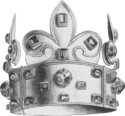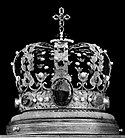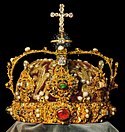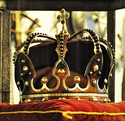
The Stone of Scone, also known as the Stone of Destiny, is an oblong block of red sandstone that was used in the coronation of Scottish monarchs until the 13th century, and thereafter in the coronation of English and later British monarchs. The Stone measures 26 by 16.7 by 10.5 inches and weighs approximately 335 lb (152 kg). A cross is roughly incised on one surface, and an iron ring at each end aids with transport. Monarchs sat on the Stone of Scone itself until a wooden platform was added to the Coronation Chair in the 17th century.

A crown is a traditional form of head adornment, or hat, worn by monarchs as a symbol of their power and dignity. A crown is often, by extension, a symbol of the monarch's government or items endorsed by it. The word itself is used, particularly in Commonwealth countries, as an abstract name for the monarchy itself, as distinct from the individual who inhabits it. A specific type of crown is employed in heraldry under strict rules. Indeed, some monarchies never had a physical crown, just a heraldic representation, as in the constitutional kingdom of Belgium.

A coronation is the act of placement or bestowal of a crown upon a monarch's head. The term also generally refers not only to the physical crowning but to the ceremony wherein the act of crowning occurs, along with the presentation of other items of regalia, marking the formal investiture of a monarch with regal power. Aside from the crowning, a coronation ceremony may comprise many other rituals such as the taking of special vows by the monarch, the investing and presentation of regalia to the monarch, and acts of homage by the new ruler's subjects and the performance of other ritual deeds of special significance to the particular nation. In certain Christian denominations, such as Lutheranism and Anglicanism, coronation is a rite. As such, Western-style coronations have often included anointing the monarch with holy oil, or chrism as it is often called; the anointing ritual's religious significance follows examples found in the Bible. The monarch's consort may also be crowned, either simultaneously with the monarch or as a separate event.

In the United Kingdom, the Accession Council is a ceremonial body which assembles in St James's Palace in London upon the death of a monarch to make formal proclamation of the accession of the successor to the throne. Under the terms of the Act of Settlement 1701, a new monarch succeeds automatically. The proclamation confirms by name the identity of the new monarch, expresses loyalty to the "lawful and rightful Liege Lord", and formally announces the new monarch's regnal name, while the monarch and others, in front of the council, sign and seal several documents concerning the accession. An Accession Council has confirmed every English monarch since James I in 1603.

The Crown Jewels of the United Kingdom, originally the Crown Jewels of England, are a collection of royal ceremonial objects kept in the Jewel House at the Tower of London, which include the coronation regalia and vestments worn by British monarchs.

St Edward's Crown is the centrepiece of the Crown Jewels of the United Kingdom. Named after Saint Edward the Confessor, versions of it have traditionally been used to crown English and British monarchs at their coronations since the 13th century.

The Imperial State Crown is one of the Crown Jewels of the United Kingdom and symbolises the sovereignty of the British monarch. It has existed in various forms since the 15th century. The 1937 version is worn by a new monarch for the first time in the royal procession following their coronation and subsequently used at State Openings of Parliament. The crown is adorned with 3,170 precious stones, including the Cullinan II diamond, St Edward's Sapphire, the Stuart Sapphire, and the Black Prince's Ruby.
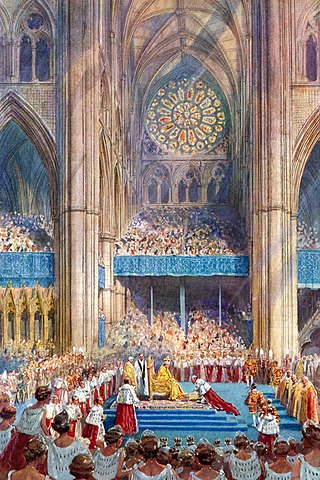
The coronation of the monarch of the United Kingdom is an initiation ceremony in which they are formally invested with regalia and crowned at Westminster Abbey. It corresponds to the coronations that formerly took place in other European monarchies, which have all abandoned coronations in favour of inauguration or enthronement ceremonies. A coronation is a symbolic formality and does not signify the official beginning of the monarch's reign; de jure and de facto their reign commences from the moment of the preceding monarch's death or abdication, maintaining legal continuity of the monarchy.

The Coronation Chair, also known as St Edward's Chair or King Edward's Chair, is an ancient wooden chair on which British monarchs sit when they are invested with regalia and crowned at their coronations. It was commissioned in 1296 by King Edward I to contain the Stone of Scone, which he had captured from the Scots. The chair was named after Edward the Confessor and for centuries it was kept in his shrine at Westminster Abbey.

An enthronement is a ceremony of inauguration, involving a person—usually a monarch or religious leader—being formally seated for the first time upon their throne. Enthronements may also feature as part of a larger coronation rite.

The monarchy of Australia is a key component of Australia's form of government, embodied by the Australian sovereign and head of state. The Australian monarchy is a constitutional one, modelled on the Westminster system of parliamentary government, while incorporating features unique to the constitution of Australia.

The monarchy of Tuvalu is a system of government in which a hereditary monarch is the sovereign and head of state of Tuvalu. The current Tuvaluan monarch and head of state since 8 September 2022 is King Charles III. As sovereign, he is the personal embodiment of the Tuvaluan Crown. Although the person of the sovereign is equally shared with 14 other independent countries within the Commonwealth of Nations, each country's monarchy is separate and legally distinct. As a result, the current monarch is officially titled King of Tuvalu and, in this capacity, he and other members of the royal family undertake public and private functions domestically and abroad as representatives of the Tuvaluan state. However, the King is the only member of the royal family with any constitutional role.

The coronation of the emperor of Russia from 1547 to 1917, was a highly developed religious ceremony in which they are crowned and invested with regalia, then anointed with chrism and formally blessed by the church to commence his reign. Although rulers of Muscovy had been crowned prior to the reign of Ivan III, their coronation rituals assumed overt Byzantine overtones as the result of the influence of Ivan's wife Sophia Paleologue, and the imperial ambitions of his grandson, Ivan the Terrible. The modern coronation, introducing "Western European-style" elements, replaced the previous "crowning" ceremony and was first used for Catherine I in 1724. Since tsarist Russia claimed to be the "Third Rome" and the replacement of Byzantium as the true Christian state, the Russian rite was designed to link its rulers and prerogatives to those of the so-called "Second Rome" (Constantinople).

Napoleon and Joséphine were crowned Emperor and Empress of the French on Sunday, December 2, 1804, at Notre-Dame de Paris in Paris. It marked "the instantiation of [the] modern empire" and was a "transparently masterminded piece of modern propaganda".
Coronations in Asia in the strict sense are and historically were rare, as only few monarchies, primarily in Western Asia, ever adopted the concept that the placement of a crown symbolised the monarch's investiture. Instead, most monarchies in Asia used a form of acclamation or enthronement ceremony, in which the monarch formally ascends to the throne, and may be presented with certain regalia, and may receive homage from his or her subjects. This article covers both coronations and enthronement.

Coronations were previously held in the monarchies of Europe. The United Kingdom is the only monarchy in Europe that still practises coronation. Other European monarchies have either replaced coronations with simpler ceremonies to mark an accession or have never practised coronations. Most monarchies today only require a simple oath to be taken in the presence of the country's legislature.

From 1947 to 1956, the Dominion of Pakistan was a self-governing country within the Commonwealth of Nations that shared a monarch with the United Kingdom and the other Dominions of the Commonwealth. The monarch's constitutional roles in Pakistan were mostly delegated to a vice-regal representative, the governor-general of Pakistan.
The coronation of the monarch of Thailand is a ceremony in which they are formally consecrated by anointment and crowning. The ceremony is divided into two main events: the coronation rites and the celebration of the Assumption of the Residence. The coronation rites are a blend of Hindu and Buddhist traditions dating back several centuries. The rites included the purification bath of the king, the anointing of the king, the crowning of the king, and the investiture of the royal regalia, the royal utensils, and the royal weapons of sovereignty. The Assumption of the Residence is a private housewarming celebration by members of the royal family at the Grand Palace.

The Coronation Theatre: Portrait of HM Queen Elizabeth II was painted by Ralph Heimans in 2012 to mark the Diamond Jubilee of Queen Elizabeth II. While the sitting took place in Buckingham Palace, the Queen is portrayed in Westminster Abbey, standing at the centre of the Cosmati pavement where she had been crowned 60 years previously. The mosaic pavement, referred to by Shakespeare as "the floor of heaven", is rich in symbolism and was created to evoke the "eternal pattern of the universe". It has been an integral part of the coronation ceremony since Henry III of England and is where every English monarch has been crowned for the last 900 years.



